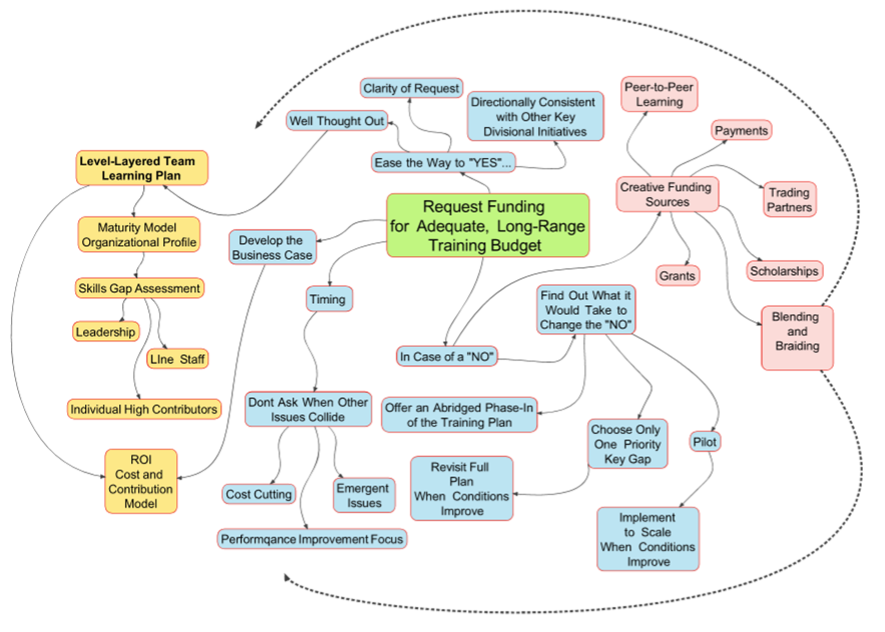Timothy Hagler
At home in South Carolina we have a saying that is especially poignant when we see one of our good friends hanging out with their old hunting dogs. We say, “’tarnt a new trick ‘atwixt ‘em.”
While the truism that old dogs aren’t very quick at learning new tricks is fun to say, it is in actuality the planned organizational maturity of the supply chain department that in itself (when competently observed and modeled) unlocks powerful planning and funding steps to enable our most effective ongoing learning potential.
The Two Keys:
The first key is to equip ourselves with an approach to illustrate and communicate how a specific training plan will support the maturity and strategic differentiation of the organization. Such an approach is the level-layered training plan matrix.
Communication difficulties can be mitigated as the training plan can be deconstructed by identifying how individual training needs aggregate to meet a skill gap analysis relative to your team’s needs along an agreed-to supply chain maturity model. Individual organizational tiers (leadership, individual high contributors, and line staff) will represent specific business functions that will require discrete educational solutions.
See the example below of a level-layered training plan matrix.
Your compelling modeling and profiling of the various levels of supply chain organizational maturity will be the foundation from which your Level-Layered Training Plan will develop (in this example the organization has charted a path to a patient-centered, networked value creation model).
With the organizational profile in hand you have a guide to conduct a skills gap assessment. That assessment will in turn drive a training plan for leadership, individual contributors, and line staff levels of the supply chain organization.
The second key is funding your training plan. There are two approaches to funding job and skills training, operating budget, and creative third-party funding.
Budget Funding: Making a successful appeal for operating budget funding is the simplest method to accrue for, track payback, and administer. As the organization matures, so does the capacity and opportunity for incremental value generation. It will enhance your chances for a long-range funding approval to show that the contribution from organizational design is accumulatively incremental while training plan net expenses are statically additive. In the example, we see that ROI can be estimated to satisfy the hurdle rate in the first 90–180 days from initial training.
Even with such substantial payback as demonstrated in our example, there is still something to be said for timing. Environments of intensive cost cutting, times when organizational focus is taken up with emergent issues, or when under the microscope of specific performance improvement initiatives may not be wise times to ask for an advanced training budget approval.
Creative funding sources: There are multiple avenues for funding training through grants, peer-to-peer training exchanges, payment plans, crowd funding, scholarships, as well as blended and braided funding sources. These may be fully funded opportunities, or may require a partial investment from operating funds.
Peer-to-peer training exchanges: There are likely network peer organizations that have a specific strength paired with a need to build up a skill that your team possesses. These organizations can be approached for cohort learning. As an example: If you have identified a skills gap in product knowledge, your cohort may possess a specialized item-level familiarity that they would trade their hosting of a training event for an in-service on effective exchange cart inventory management.
Trading partner support training: When conducting best and final negotiations for products, equipment, and services, you have an opportunity to negotiate related training as/like their in-house teams receive. That can be first-call or board replacement training for a piece of medical equipment, or advanced super-user level training for software applications. Almost any live trading partner negotiation can include a training component. Savvy negotiators will look for relevance and elements of mutual benefit.
Payment plans: At times just extruding the cash flow can be helpful, and can be a slight financial advantage considering some available terms of Procurement Card programs with aggressive rebate structures; there can actually be other advantages beyond getting to “yes.”
Scholarships: Trade associations, GPOs, and application user groups often offer scholarships to national and regional events. While these aren’t guaranteed, they can be an effective means to stretch the training budget when available.
Grants: It is compelling to think of simply getting someone else to foot the bill for training, but grants come with a great deal of upfront and ongoing administrative accountabilities, and some grants simply have strings attached.
Obtaining training grants can be a complex process, but worthwhile pursuing. Key points to keep in mind:
- The opportunities are real and are offered through granting authorities you can trust.
- Before applying for a grant, always check your eligibility and carefully consider your ability to meet grant requirements.
- To increase your chances for success, follow application instructions to the letter and prepare a thoughtful, thorough response.
- Grantmaking agencies want you to succeed! So get whatever help you need to navigate the process, including all information from their web site, or individual conversations with their officers or past grant awardees.
- Visit www.careeronestop.org for guidance on job training grants from multiple state and federal agencies.
Blending and Braiding: Blending of funding sources occurs when you create a general education and training pool and multiple sources contribute to the pool and the resources are distributed as they are requested. Braiding is when a funding strategy taps into existing allocation streams and uses them to support unified initiatives as a flexible and integrated approach. Braided funding differs from blended funding in that in braiding the funding streams remain visible. Both blending and braiding are effective when there exists a high degree of collaboration and even pride of sponsorship amongst funding agencies. An example would be setting up a collection and re-distribution depot to provide surplus medical supplies to third-world countries as a laboratory to train staff on the effective elements of reverse supply chain.
This effort may bring together peer-to-peer training, trading partners, community philanthropic organizations, federal grant sources, as well as established non-profit redistribution organizations. Collaborative braided funding strategies also lead to the viability of crowdfunding as these programs often have appeal for community benefactors. Collaboratively all involved can take a great deal of pride in what develops in the nexus of all these specific interests.
The mind map above is a vivid description of connected issues to a training plan and funding strategy as presented.
I hope this article has helped you think through using the rigorous framework of an organizational maturity model as a base and helpful guiding matrix to provide luminance to a skills gap analysis and ultimately applying a training schedule that will drive significant incremental returns. If you have the capacity for program administration beyond tracking to journal entries in an operating budget, some of these creative funding ideas may be in your future as well, but whenever possible, budget funding, while requiring an element of salesmanship, will keep the process more focused on the core calling of healthcare delivery network supply chain…“filling the hands that heal.”
Timothy Hagler is an experienced supply chain leader, with an ever-accelerating interest in earnestly connecting stakeholders with creative ideas to meet new economic realities for healthcare providers. Tim has enjoyed an excellent track record of achievement and advancement earned through demonstrated contribution to bottom-line results, employing strong solutions architecture, analytic and financial skills in challenging, multi-client environments. Tim and his lovely wife Kandy enjoy spending time at the beach in South Carolina. Tim’s hobbies include photography, American folk music, and writing about himself in the third person. Read more of Tim’s articles on his blog at www.thinkoutsideinsupplychain.com.







